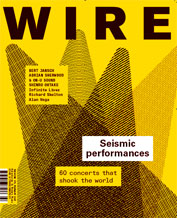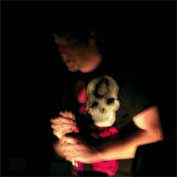Global ear: Basque country
January 25th, 2007

Erresuma batuko The Wire aldizkariak, euskal herriko musika esperimentalen inguruko idatzi bat argitaratu du otsailako alean. Orrialdeko tamaina duen artikuluan (ondotik berezko hizkuntzan gehitzen duguna), Mattin-ek inguruotako musikagintzaren ezaugarri eta egitasmo zenbaiten buruzko azaleko errepaso bat egiten du.
El magazine inglés The Wire publica en su número de febrero un artículo sobre los movimientos en torno a las músicas experimentales en el pais vasco. En dicho artículo (que reproducimos a continuación y en idioma original), de una página, Mattin repasa por encima algunas características y proyectos de estos alrededores.
GLOBAL EAR: BASQUE COUNTRY
BY MATTIN
Ondamendia (?catastrophe? in Basque) is a recent work by the multidisciplinary artist Oier Etxeberria questioning the general health of Basque culture. Ondamendia is a collection of parodies of Basque iconic images in the format of postcards accompanied by a 20 minute-long 3″ CD of concrète music called C14. The name is taken from Carbono 14, a radioactive isotope of carbon which is used to measure the age of an object in archaeological research. The title is an ironic reference to the ancestry of Basque Culture (Euskara the Basque language is the oldest living language in Europe). C14 combines fragments of typical Basque folk sounds made by Txistularis (flute players), Bertsolaris (poetry improvisers) and some classic songwriters from the Basque Country such as Mikel Laboa and Benito Lertxundi. These fragments are
sometimes processed and mixed with other sounds more related to contemporary life such as advertisements and cash machines. Running alongside this is an underlying narrative of an autopsy performed on a body. “It seems dead,” you hear the doctors comment, “but sometimes it seems to re-animate.” According to Etxeberria, this pseudo-zombie is a metaphor for the actual status of Basque culture. In an informal conversation at the end of last year he commented : “Because the Basque culture is such a minority, it really needs to rely strongly on
itself. Unfortunately this means that it often lacks criticism.”
As many readers will be aware the Basque Country has particular sociopolitical problems coming from the impossibility of being able to decide whether or not to be a sovereign nation due to it’s bureaucratic location in the north of Spain and the south of France. These problems are often misused by the media to serve the agenda of different political parties. Musicians in this part of the world are therefore understandably reluctant to be part of over-simplified modes of representation. At the governmental institutions run by the PNV (the Basque Nationalist Party which has been in power for the last 25 years), the purity of the Basque folk tradition and its historical construction remains unquestioned. However, works such as C14 bring new possibilities of dealing with one’s own heritage. Humour, imagination and conceptual rigour makes this work an interesting platform for discussion about the notion of Basqueness.
This summer in 2006, a meeting called MRB | AMM was organised in Arteleku by Audiolab and myself where people involved with experimental music had the opportunity to spend three days talking about what we are doing and how it relates to such a specific context. Among many discussions, the one about the problems of generating a scene stood out: how to avoid generalisations, simplifications and the dichotomy of who is in and who is out. This is something that we really know in the Basque Country as one is often forced to define oneself either as Basque or Spanish. Contrary to this, if there is something characteristic about the musicians now working in the Basque Country, it is their diversity. The variety of approaches, from Alex Mendizabal’s constant questioning of what music is and Arakis’ personal questioning of gender (apart from making electronic music, s/he is an international renowned curator dealing with issues of feminism and queer theory), to the industrial and dark soundscapes of Tzesne and his young and very enthusiastic friend Tüsüri (who, apart from being a musician runs the Webzine Sototik, a radio programme and a Net label) is mind blowing. Other examples of the Basque multitude are Pilar Baizan, characterised by her double life as Miss Toll (Electroclash) and Baseline (old school power electronics), the classically-trained cellist Maite Arroitajauregi, “el palo· (stick) player Iñigo Telletxea, Löty Negarti and his pranks and anti-virtuosism (Negarti also runs Hamaika, the most refreshing noise and improv label that I have encounter recently), the broken glamour of Baba Llaga, and the surprising re-birth of Cancer Moon singer Josetxo Anitua as the beast of improvisation in Josetxo Grieta.
It is not by chance that so many musicians are emerging from the Basque Country right now. For several years a handful of committed people have worked hard to develop a fertile ground for experimentation. Xabier Erkizia of Audiolab is not only one of the most talented musicians that I have ever met, but also an activator, someone who is constantly injecting questions and developing projects where the participants have to take an active role. At San Sebastian’s Arteleku, a contemporary art centre, he has developed Audiolab, a laboratory for the development of experimental music. Audiolab organises workshops, talks, presentations and concerts as well as other activities. It is also a studio where people are welcome to explore the universe of sound. Another project that Erkizia is part of, together with Dimitris Kariofilis,
is [UN]COMMON SOUNDS, a theoretical and practical research into the international experimental music community. Kariofilis has also recently released a CD of tracks by young Basque artists on his label Antifrost.
The Ertz collective was founded by Erkizia in the year 2000, and has organised a festival in the small but beautiful town of Bera for the last seven years. Thanks to Ertz and the Musica Ex Machina festival in Bilbao, people have been able to see performances by many of the interesting international artists working right now. While Ertz is mainly concerned with sound art, the MEM festival is trying to bring back the image of Bilbao as an industrial city in cultural terms, focussing on the rougher side of things presenting international noise artists alongside emerging local talent. MEM has helped to make the city’s underground culture more dynamic through organising noise concerts in different venues such as a sixth-floor metal workshop in the neighbourhood of San Francisco and at Bilborock, a church dedicated to the preaching of Rock and Roll. Another interesting place is the Matadero of Azkoitia, a squatted ex-slaughter house that has been organising concerts for many years. This is also the territory of the legendary cult band Akauzazte, an obsessed, dense and obscure experimental rock band singing in Basque who on a good day can beat any other such act, even though they are not so well known outside the Basque Country. Furthermore, Akauzazte, Tzesne and the Ertz collective have just started a new DIY distributor and Net based shop called Arto Artian, where you will be able to find the works from many of these talented and challenging artists. So even if former
Akauzazte member Oier Etxeberria thinks that Basque culture needs some serious revitalisation, it seems obvious to me that it is already getting some potent electric shocks in the form of experimental music.














![proyecto de documentación e investigación de la creación sonora experimental [UN]COMMON SOUNDS](wp-content/uploads/2010/04/uncom_blog.thumbnail.jpg)

October 12th, 2012 at 11:10 pm
[...] argitaratu du bere Global Ear atalean Euskal herriko musika eskenari buruzko artikulu berezi bat. Orain urte batzuk idatzitako hartan Euskal herriko musika esperimentalei errepaso bat ematea bazen a…, oraingoan Mark Lorek politika, hizkuntza eta independentzia bezalako kontzeptuak hartu ditu [...]